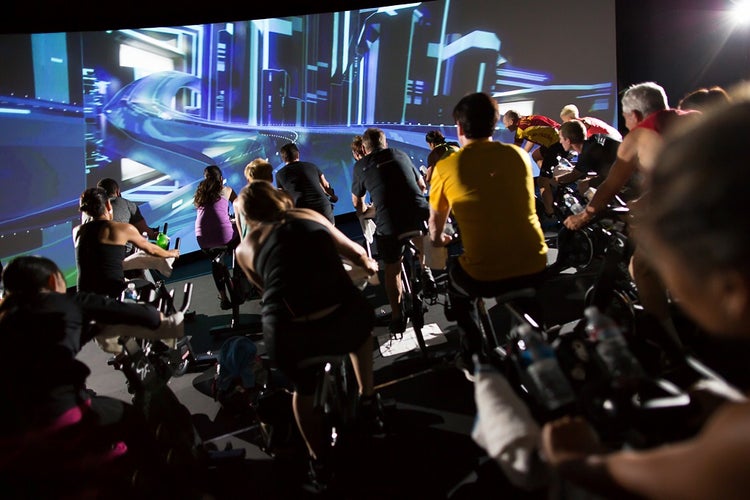Cycling Transported

Forget about cruising through mountain passes and sunsets: Imagine you’re pumping up and careening down slick catwalks that snake in and around towers and beacons in a 26th-century cityscape. Speed is all that keeps you on these narrow, floating tracks through a space-age metropolis.
Immersive cycling environments are providing early insights into the fact that our bodies and minds are capable of more than we think, when they get a little nudge from virtual reality. Even 2D displays that now seem primitive have been shown to keep study participants going. Research conducted by Institute of Movement Sciences, CNRS & Aix-Marseille University, France in 2011 using 2D displays to create a virtual reality (VR) environment found that VR reduced participants’ perceived degree of exertion. Riders were less aware of their physical environment and enjoyed their experience more than a control group who rode without VR.
One of the study’s authors, Daniel Mestre, told Gizmag, “The main advantage of using VR feedback is distraction” and more than, say, television, “VR gives you contextualized information about the exercise you are doing, and is thus much more than distraction.”
Les Mills and Reebok piloted the concept of “immersive fitness” in pop-up environments throughout Asia and Europe – the brainchild of Les Mills Jr. and Adam Lazarus, who were inspired by the entertainment industry’s immersive tents and innovative use of video at festivals and concerts. Based on their understanding of exercise physiology and fitness programming, they banked on the likelihood that a “heightened sense of anticipation and reward” as well as the body’s visceral response to visual immersion would lead participants to suspend disbelief and stop thinking about the length of their workout.
The pilots led to several exclusive, permanent locations worldwide (including 24 Hour Fitness in Santa Monica, Calif.). Les Mills and Reebok have just issued the fourth release of THE TRIP, an immersive cycle class that synchronizes movement and music with video content in a purpose-built studio.
Device manufacturers are also working to influence our minds and in turn, help change our bodies. They have products on the drawing board or in prototype including a VR headset-and-home-gym-device combination, as well as a resistance controller that pairs with Microsoft Kinect.
Based on feedback on the maiden voyage of THE TRIP, Mills Jr. and Lazarus’ bet is spot-on. One self-described “non-cycle/spin type of person” says, “the visual element in THE TRIP makes all the difference in the world to me” when combined with great instruction and music, to make “a fun challenge.”
There’s also something else that happens when virtual reality is an element of group fitness. One participant says the benefits far greater than distraction: besides helping him manage his Type-1 diabetes, THE TRIP puts him in “a competitive state of mind that I never knew I really had in me, even on those days that I think I can’t” give the workout everything he’s got. And a new mom and former endurance athlete finds her classmates and instructors are committed to inspiring one another “in a unique way that I’ve only experienced in this class.”